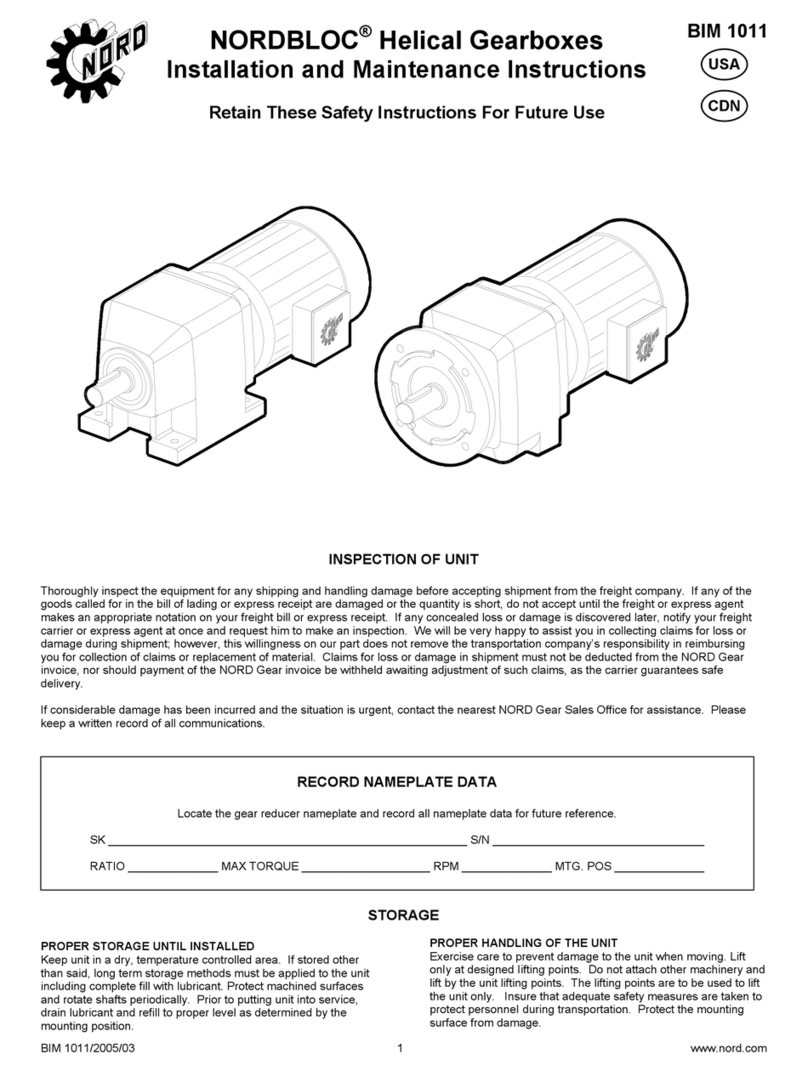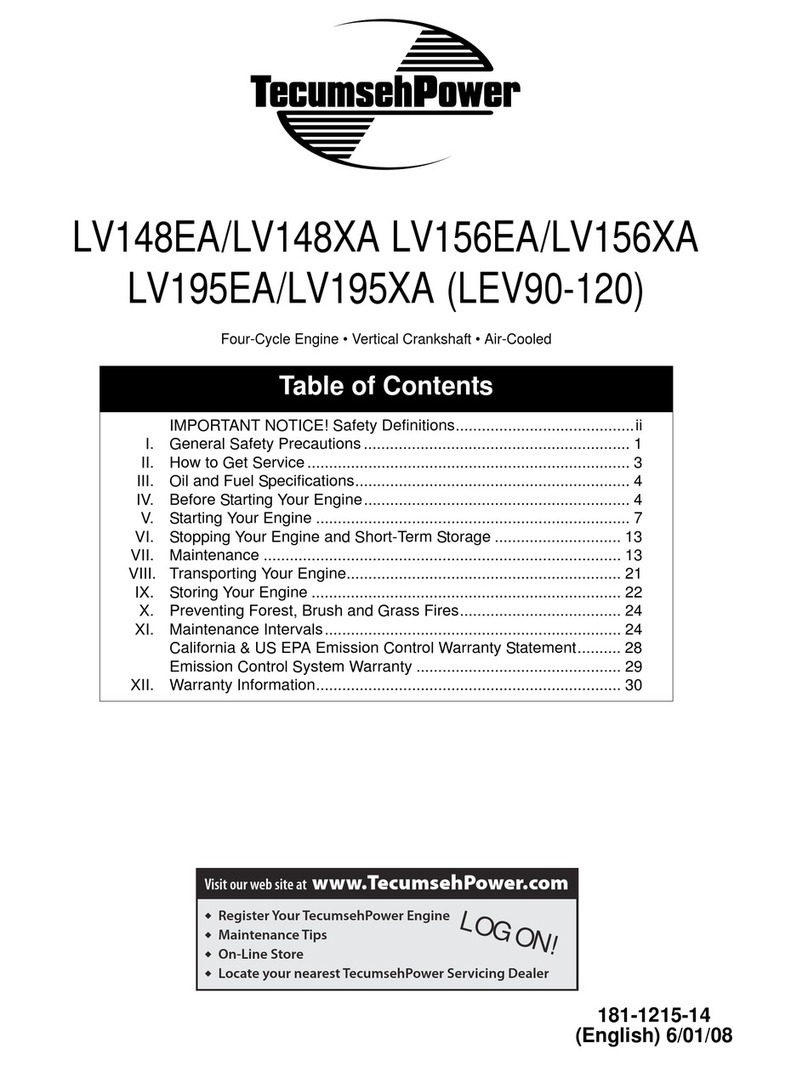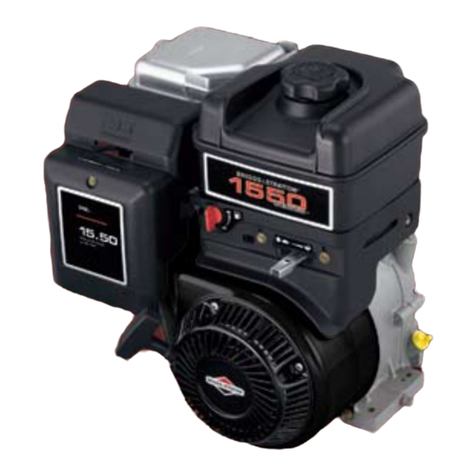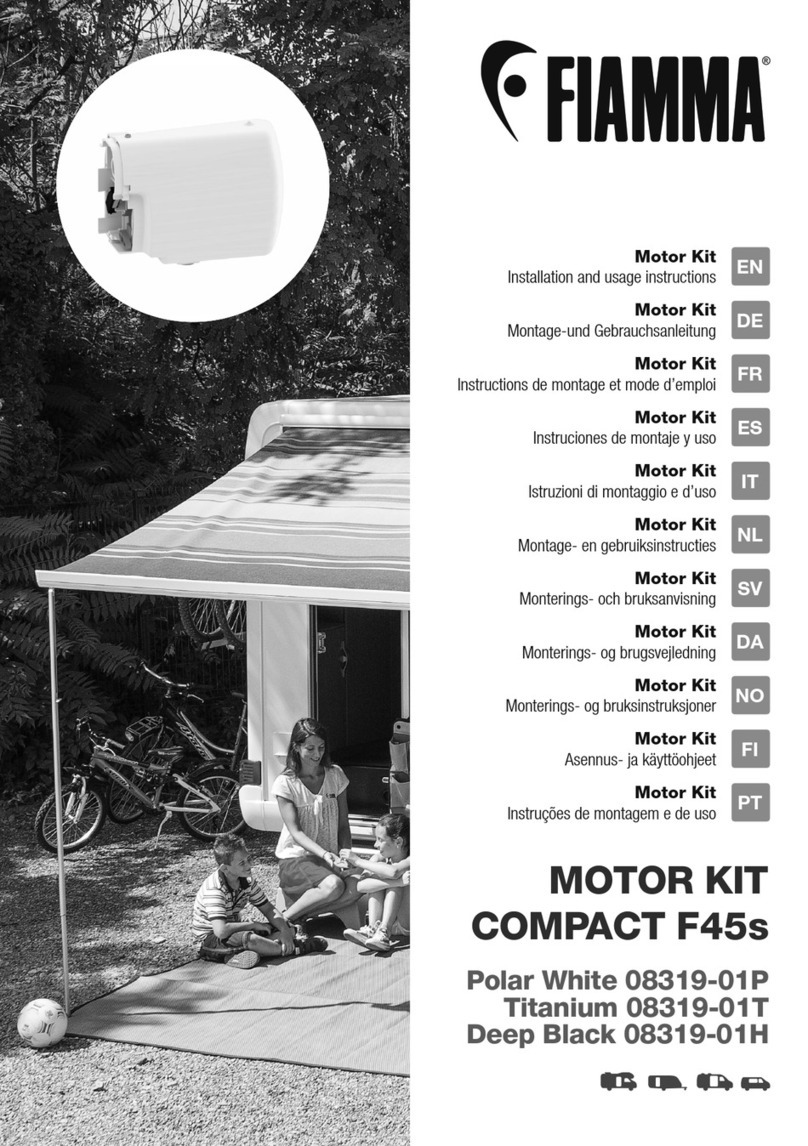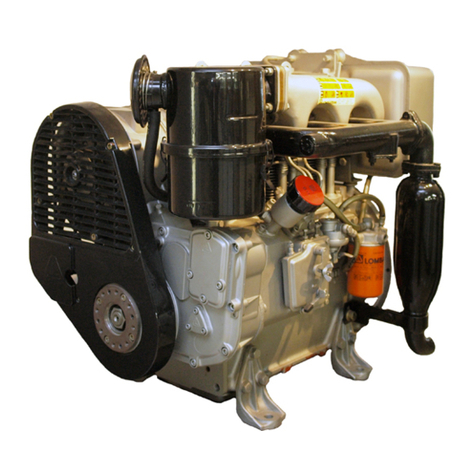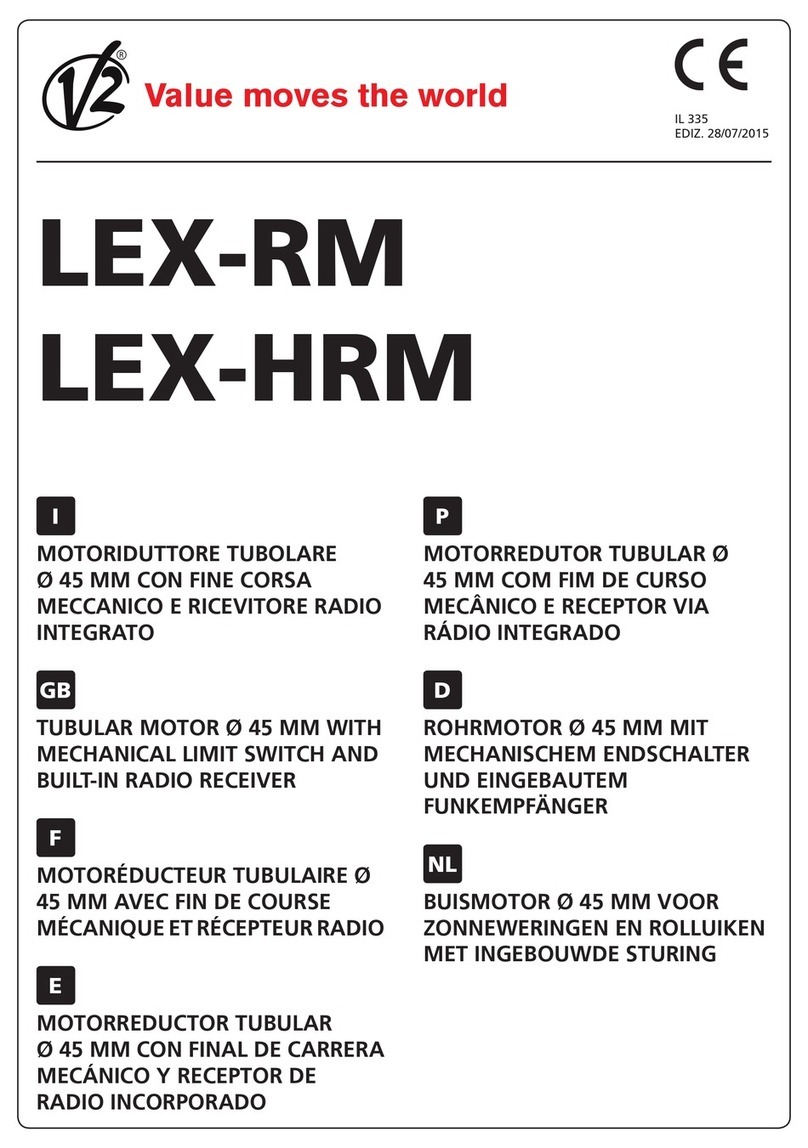Hama GN15-VF User manual

Engine block 1A-1
1.1.1 Technical Parameters
Technical Parameters of Complete Equipment
Item Parameter Remark
Model GN15-VF GN16-VF GN16-VF1
Cylinder quantity and
arrangement In-line 4-cylinder
Combustion chamber Roof shape
Ignition sequence 1-3-4-2 By cylinder number
Rotation direction Counterclockwise From back to front (flywheel
side taken as the back end)
Valve timing mechanism dual overhead camshaft, timing chain
drive (silent chain), intake VVT
Valve quantity 16
Displacement (cc) 1497 1591
Bore× stroke (mm) 74.8×85.2 74.8x90.5
Compression ratio 10 10
ON -14~26(BTDC)
Intake
OFF 66~26(ABDC)
ON 39(BBDC)
Valve
timing
(°) Exhaust
OFF 5(ATDC)
Max. power(kW/rpm) 77/6000 81.5/6000 85/6000 Net power
Max. torque(N·m/rpm) 140/4000 149/4000 153/4000 Net torgue
Air conditioning idle speed:800±50
Idle speed (rpm)
Target idle speed:750±50
Ignition advance angle(°) 3~10 Idle state
Starting mode Electrical starting
Cooling mode Water cooling forced circulation
Lubricating mode Pressure, Split, Complex
Overall dimension (mm) 573.2×615.0×606.3 573.32x724.2x6063
Net weight (kg) 94.8 96.5

Engine block 1A-7
Tightening torque
Torque value
Mounting place N•m kgf•m
Remark
Power generator
Bracket 45.1 4.6
Adjusting arm 45.1 4.6
Adjusting slider 21.6 2.2
Power generator pivot’s bolt and nut 45.1 4.6
Ignition, control system
Ignition coil 8.8 0.9
Spark plug 25 2.6
Fuel rail 21.6 2.2
Camshaft position sensor 8.8 0.9
Water temperature sensor 15 1.53
Knock sensor 21.6 2.2
Knock sensor bracket 16.8 1.7
Crankshaft position sensor 8.8 0.9
OCV valve 8.8 0.9
Intake and exhaust system
Throttle body 8.8 0.9
Intake manifold 21.6 2.2
Intake manifold bracket (manifold side) 21.6 2.2
Exhaust manifold 21.6 2.2
Exhaust manifold bracket (cylinder
body side) 21.6 2.2
Exhaust manifold bracket (manifold
side) 45.1 4.6
Exhaust manifold heat shield 8.8 0.9
Lubricating system
Oil switch 14.7 1.5
Oil filter 14.0 1.43
Oil filter adapter 21.6 2.2
Oil filter 8.8 0.9
Oil sump 8.8 0.9
Cylinder body, crank connecting rod mechanism
50±2 16.7
Crankshaft pulley 60±2°
First set the pretension torque and
then tighten the angle.
Flywheel 100 10.3

Engine block 1A-12
Oil viscosity standard Oil viscosity level
Higher than–25℃SAE10W–30
–30℃~37℃SAE5W–30
1.2.5 Replacement of Oil Filter
1. Dismantle the oil filter with special tools.
2. Rub and clean the new oil filter with a clean
cloth.
3. Smear clean oil onto the new oil filter’s
O-ring.
4. Mount the oil filter with special tools
Tightening torque:13.0~15.0N·m{1.32~
1.52kgf·m}.
5. Start the engine and inspect if there is leakage.
Inspect the oil level and check if oil adding is
needed (see Inspection of Engine Oil).
Others
Other inspection and maintenance like power
generator inspection and starter inspection etc can
be conducted on the complete vehicle. See this
manual and corresponding complete vehicle
maintenance manual for processing procedures.
1.3 Application of Engine
Maintenance Platform
1.3.1 Mount the Engine onto
Maintenance Platform
1. Lift the engine, and align the cylinder body’s
pin hole to the maintenance platform’s
mounting dowel pin to mount the engine(see
the figure).
2. Mount the work fixture according to the
figure and lock it.
3. Adjust the fixing bolt to appropriate place and
prevent the engine mounting from getting
loose.
4. Pour the engine oil into specified vessel.
5. Mount the new oil drain plug, and tighten the
oil drain plug. tightening torque: 30 ~
41N·m{3.1~4.2kgf·m}
Smear clean oil onto the
new oil filter’s O-ring.
Fixing bolt

Engine block 1A-23
figure..
Bolt Specifications and Mounting Torque
No. Specification
Bolt rod
length
(mm)
Mounting
torque
(N·m)
1a, 3a, 4a,
5a
6a, 7a, 8a,
M6 25 8~12
2b, 10b M6 30 8~12
12c M6 45 8~12
13d, 14d M10 90 36.5~42.5
1.8.7 Explanations on the oil filter
mounting
Tighten bolts by steps according to the sequence
illustrated in the figure
1.8.8 Explanations on oil pump
disassembling/ mounting
1. Dismantle oil pump and timing chain case
assembly (see oil pump and timing chain case
assembly dismantling/mounting).
2. Disassemble parts according to the sequence
illustrated in the figure.
3. Mount parts according to the sequence
reverse to the disassembling process.
1Bolt
2 Oil pump cover
3 Screw plug
4 Pressure spring
5 Control piston
6 Inner rotor (Smear oil before mounting)
7 Outer rotor (Smear oil before mounting)
1.8.9 Inspection of Oil Pump
Explanations on inspection of rotor clearance
1. Measure the following clearance, and replace
the rotor or pump body if necessary.
Standard gear tip clearance: 0.06~0.20mm
Maximum gear tip clearance: 0.22mm
Standard pump body clearance: 0.250~0.325
Maximum pump body clearance: 0.35mm
Standard backlash: 0.03~0.09mm
Maximum backlash: 0.14mm

Engine block 1A-35
1.11 Flywheel, clutch
1.11.1 Flywheel and Clutch Dismantling/Mounting
1. If the crankshaft’s back cover needs to be dismantled, oil sump body shall be dismantled at first (see
lubricating system, oil sump body dismantling and mounting).
2. Dismantle parts according to sequence illustrated in the figure. .
3. Mount the parts according to the sequence reverse to the dismantling process.
1 clutch pressure plate (see dismantling explanations/see mounting explanations)
2 Clutch friction disc (see dismantling explanations/see mounting explanations)
3 flywheel (see dismantling explanations/see mounting explanations)
4 Crankshaft’s back cover (see the rear oil seal dismantling explanations /see rear oil seal
mounting explanations /see mounting explanations)
5 Transmission’s baffle plate

Electronic Fuel Injection Control System 1B-4
Tool name: Vacuum Meter
Function:
Inspect the pressure in the intake manifold.
Tool name: Cylinder Pressure Gauge
Function:
Inspect every cylinder’s pressure.
Tool name: Fuel Pressure Gauge
Function:
Inspect the fuel system’s pressure, and judge the fuel
system’s fuel pump extrusion as well as the pressure
regulator’s working condition.
Tool name: Tail gas analyzer
Function:
Inspect the vehicle’s tail gas emission, which helps locate
the electronic fuel injection system’s faults.

Electronic Fuel Injection Control System 1B-12
the electronic control unit will immediately set the
fault information record in RAM fault memory,
and save it in the form of fault code, which will be
displayed according to the fault occurrence
sequence. According to the fault frequency, faults
can be classified into “Steady-state Faults” and
“Sporadic Faults” (like the faults resulting from
short-lived open circuit or poor contact between
connectors)
Fig. 2.4 Electronic Fuel Injection System’s Troubleshooting Principle
2.4.2 Classification of Fault Types
Diagnostic Fault Path and Fault Categories
Diagnostic fault path (DFP) is, in fact, a
sub-function for fault diagnosis that is used to
inspect functions of a given sensor, actuator, or
others in the EMS system. By respective
diagnostic path, the fault information will be
transmitted to the fault diagnosis management
module, which will take corresponding actions
and determine if the fault lamp should be activated
or the fault should be displayed on the diagnostic
unit. When a fault is detected at a given DFP, the
fault diagnosis management module will make
definite the fault type. Usually, the fault types
include:
B_mxdfp Maximum fault, signal goes beyond the
upper limit of the normal range.
B_mndfp Minimum Fault, the signal goes beyond
the lower limit of the normal range.
B_sidfp signal fault, without signal.
B_npdfp unreasonable signal, with signal, but
the signal is unreasonable.
Definitions of Fault Types
In this project there are 10 fault types. Closed fault
path is defined as “Class0”, namely, the fault
information will not enter the fault memory, and
also the diagnostic unit will not read the fault. In
addition, faults of Class2, Class3, Class4, Class5,
Class6, Class7, Class11, Class12, and Class13
belong to those fault types that have been defined
by the system in a uniform manner.
Class2: fault is inputted into the fault memory upon
taking place; DFP fault types relating to misfire are
usually defined as Class 2. As for the misfire fault
resulting in damage of catalyst, the MIL lamp will
flash in no time to prompt the driver. As for the
misfire fault resulting in deterioration of emission, if
the misfire fault of corresponding extent has been
fully detected in three consecutive driving cycles, the
MIL lamp will be activated, and also the fault will be
displayed on the diagnostic unit. If the fault fails to
be confirmed or eliminated in 40 driving cycles
(namely, in a warm-up cycle, E_xxx=1, but Z_xxx
=0), the fault information will be deleted from the
fault memory. if the fault disappears before the fault
confirmation and never occurs within 40 driving
cycles, the fault information will be deleted from the
fault memory; If the fault disappears after being
confirmed, the fault information cannot be deleted
from the fault memory until it does not occur within
40 warm-up cycles, and the fault priority is defined
as 20. After the fault confirmation, SVS lamp is off.
If the fault disappears after the fault confirmation and
never occurs within three driving cycles, it means
that the fault has been corrected.
Class3: fault is inputted into the fault memory upon
taking place. After the fault confirmation, the MIL
lamp is activated, and the fault confirmation needs
three driving cycles, with fault being displayed on the
diagnostic unit. If the fault fails to be confirmed or
eliminated within 40 warm-up cycles(namely, in a
warm-up cycle, E_xxx=1, but Z_xxx=0), the fault
information will be deleted from the fault memory; if
the fault disappears before the fault confirmation and

Electronic Fuel Injection Control System 1B-34
5 Functional Requirements on ME7 System’s Diagnostic Unit
Functions required:
I. Self-diagnosis
Mostly including: read fault code, and clear fault code;
II. System Parameter Display
Mostly including: including: water temperature, air intake temperature, throttle opening, engine rotating
speed, ignition angle, A/F ratio short-term modification, A/F ratio long-term plus and multiplication
modification, intake pressure, intake flow, oxygen sensor signal, system voltage, and torque demand value
etc;
III. System Modes
Mostly including: display of 10 modes like programming, cooling system, stable working condition,
dynamic working condition, emission control, oxygen sensor, idling speed, fault indicator, emergency
operation, and air conditioning etc.
IV. Actuator Test
Mostly including: six function tests on fault indicator, fuel pump, air conditioning relay, fan control,
ignition test, and single-cylinder oil interruption;
V. System Initialization Resetting (self-adaption stop resetting)
After being stalled, engine will send the initialization directive, and the system will stop resetting previous
self-adaption.
VI. Speedometer
Mostly including: display of vehicle driving mileage and driving time;
VII. Version Information
Mainly including: display of car frame number (optional), ECU hardware number, and ECU software
number
5.1 Parts Mounting Torque Specification Table
No. Part Name Mounting Torque (N·m)
1 Coolant temperature sensor 39.2 (Max)
2 Knock sensor 20±5
3 Oxygen sensor 50±10
4 Rotating speed sensor 10±2
5 Phase sensor 10±2
6 Magnetic fuel injector 6
7 Electronic accelerator pedal 6±0.5
8 Electronic throttle 10 (Max)
9 Brake vacuum degree sensor 10±2

Fuel System 1C-6
fuel pipe dismantling” to complete the
under-mentioned work (see the Fuel System,
Explanations on Plastic Fuel Pipe Dismantling)
3. Dismantle the main fuel hose (fuel supply
pipe assembly) from the main pipe (fuel rigid
pipe).
4. Connect the special tool’s quick connector
with the fuel distributor(fuel rail), and insert
the fuel supply pipe assembly onto the special
tool’s interface.
5. Remount the accumulator’s negative cable.
Caution
Wrong connection with other wiring terminals
may lead to fault, and so caution is needed
during the connection process.
6. Connect the DLC’s wiring terminal F/P with
the Vehicle body’s earthing point GND with a
jumper wire.
7. Turn the ignition switch to “ON” position to
make fuel pump run, and measure the
pipeline’s maximum oil pressure.
Standard value
390~410kpa
8. Turn the ignition switch to the “OFF”
position and loosen the jumper wire.
If the pressure is higher than the standard value,
inspect the fuel pump’s maximum pressure
If the pressure is normal, inspect if the oil
return pipe and pressure regulator suffer
blockage.
If the pressure is lower than standard value,
turn the switch handle and measure the oil
pressure’s variation (see the figure).
—If the oil pressure rises speedily, inspect the
pressure regulator.
—If the oil pressure rises slowly, inspect the oil
pressure’s maximum value.
If the oil pump’s maximum pressure is normal,
inspect if the oil circuit between the oil pump
and pressure regulator suffers blockage.
9. Dismantle the special tool unit.
Caution
To avoid the quick connector’s damage or oil
leakage, follow the “Explanations on plastic
fuel pipe dismantling” to complete the
under-mentioned work (see the Cylinder
Dismantling/Mounting, Explanations on
Plastic Fuel Pipe Dismantling)
10. Connect the main fuel hose (fuel supply pipe
assembly) and the main pipe (fuel rigid pipe)
11. Complete the inspection work after repair (see
Inspection Work after Repair).
1.3.4 Inspection of Fuel Pressure
Maintenance
Warning
Fuel overflow or leakage is dangerous, and
the fuel is combustible, which may lead to
personnel injury. In addition, the fuel has side
effect on the skin and eye.
Switch handle
To main pipe
Fuel distributor
Earthing
j
umpe
r
Switch handle
To main pipe
Fuel distributor

Steering system 2E-14
3. Turn back the gear chamber, and press the
rubber supporting block, until the rubber block
comes out of its other side.
4. Align the rubber supporting block to steel pipe.
Attentions for installing the oil seal and bush
1. Install a new “O” ring and seal ring on the rack
lever.
2. After installing the seal ring, make it tightly
affix the lever.
3. Attach a new oil seal to (49B032 325) with a
special tool (49 B032 324).
4. Remove the special tool (49B032325).
5. Place the oil seal on the edge of rack lever with
a special tool, and remove the special tool.
6. Attach a new bush to steering rack.
Note:
●While pressing it in, the applied force shall not
exceed 39kpa{400kg}cm2, 5688psi} to avoid
the damages of oil seal and bush.
●Apply a little of grease to the seal ring and oil
seal bush.
7. Install the steering rack into gearbox, and press
in the oil seal and bush with a special tool, until
it’s difficult to press.
Oil seal
Rubber mat
Steel pipe
The rubber block end is
aligned to steel pipe.

Brake system 2F-2
General and operation
Operation of brake caution light
The brake caution light (BRAKE) applied in
this brake system is located inside the instrument
panel. When the ignition switch is in ON gear, the
brake caution light will go on. When the ignition
switch returns to ACC gear, the caution light will
go out. The following cases will make the caution
light go on.
●In case of applying the parking brake when
the ignition switch is in ON gear, the caution
light will go on.
●When the level of brake fluid is below a
certain value, “BRAKE” caution light will
go on.
Description of ABS fault light
ABS fault light applied in this brake system is
located inside the instrument panel (as shown in
the figure).
Self-check of ABS: when the ignition switch is
turned from ACC to ON, the self-check of ABS is
started, and the fault light goes on. After finishing
its self-check within 0.7 to 3s, the fault light goes
out, it certifies the normality of ABS system; if it’s
constantly on, ABS system will be faulty, and the
professionals are required to check the faults of
ABS system (for its details, see the description of
ABS anti-lock system repair).
Description of ESC fault light
ESC fault light applied in this brake system
is located inside the instrument panel (as shown in
the figure).
ESC self-check: when the ignition switch is turned
from ACC to ON, the self-check of ESC is started,
and the fault light goes on at this time. After
finishing its self-check, the fault light goes out, and
it certifies the normality of ESC system; if it’s
constantly on, ESC system will be faulty, and the
professionals are required to check the faults of
ESC system (for its details, see the description of
ESC anti-lock system repair).
Description of ESC-OFF switch indicator
lamp
ESC manual switch indicator lamp applied in
this brake system is located inside the instrument
panel (as shown in the figure).
When ESC-OFF light goes on, it indicates the
functions of ESC is manually closed, its functions
can be started with ESC switch button, and ESC-
OFF light will go out after starting it.
ESC snow mode lamp located in the
instrument panel. When snow mode ESC
lighting, indicating the snow mode ESC mode is
active.

Brake system 2F-8
Repair instructions 1
(I) Repair on the vehicle
Front brake hose
Procedures for removing:
Note:
Do not spill brake fluid or splashed paint. Brake
fluid will damage the paint. If splashed paint on,
then immediately wipe clean and washed with
water.
1. Remove the wheel.
2. Remove the brake hose.
●Loosen the connector ①connected to brake
pipe.
●Block the opening of brake pipe, and avoid
the loss and pollution of brake fluid.
●Remove the snap spring ②.
●Loosen the connecting bolt ③.
●Remove the brake hose from the support.
Installation procedures:
1. Connect the brake hose to pipe ①. Tightening
torque: 14 to 18N·m.
2. Install the snap spring ②.
3. Install the brake hose connecting bolt ③.
Tightening torque: 22-29N·m.
Important: please apply the brake fluid
recommended by Sino Maersk Co., Ltd.
4. Exhaust the brake system. Refer to manual
exhaustion in this chapter.
5. Confirm whether the brake system is leaked.
6. Install the wheel.
Rear brake hose
Removal procedures:
①Remove the wheel,
②Remove the brake hose.
●Loosen the connector connected to brake pipe
①.
●Remove the snap spring ②.
●loosen bolts ③.
●Block the opening of brake pipe, and avoid
the loss and pollution of brake fluid.
Installation procedures:
1. Connect the brake hose to the pipe.
Tightening torque: 14 to 18N·m (12 Ib-ft).
2. Install the snap spring.
3. Install the brake hose connecting bolt ③.
Tightening torque: 22-29N·m.
Important: please apply only the recommended
brake fluid.
4. Exhaust the brake system. Refer to manual
exhaustion in this chapter.
5. Confirm whether the brake system is leaked.
6. Install the wheel.
Brake lamp switch
Removal procedures:
1. Disconnect the negative cable of battery.
2. Remove the brake lamp switch.
●Pull down the plug ①.

Brake system 2F-53
III. Haima S5 ESC interface circuit
3.1 ECU circuit diagram

Electrical System 3D-34
The immobilizer coil, mounted on the ignition
lock cylinder, is connected with the immobilizer
controller via the harness, which undertaken the
transmission of signals and energy between the
immobilizer controller and the transponder.
Immobilizer controller (IMMO)
The immobilizer controller is a electronic
control module consisting of the
microprocessor and various semiconductor
components and is the core component of the
immobilizer system.
Electrical Schematic Diagram
Anti-theft system electrical schematics (without
PEPS)
Anti-theft system electrical schematics (with PEPS)
System Operating Principle
After the key with a transponder is inserted into the
ignition lock and it is turned from OFF to ON, the
immobilizer controller is awakened entering the
wireless authentication status; at this time, the
immobilizer controller outputs energy and data to
the transponder via the coil. The transponder that
installed in the key receives the wireless signal and
transmits the encrypted ID signal back to the
controller via the coil. The controller decodes the
signal and compares the received ID with the
internal stored ID. If they are the same, the
wireless authentication is passed. If not, the
controller ends the identification and enters the
sleep mode.
After passing the wireless identification, the
immobilizer controller and the engine ECM will
conduct the mutual encryption and authentication.
They will compare the stored PIN with the key
respectively. If they are the same, the ECM can
start the engine successfully. If different, the ECM
won’t start the engine.
Some models, burglar match with PEPS function
keys and PEPS mainly through intelligent control
module, PEPS control module and anti-theft
controller uses an internal algorithm using UMC
between HITAG2 encryption and authentication
algorithms, security controls and engine ECM is
encrypted authentication, only the smart key and
anti-theft controller (or PEPS and security
controller), two anti-theft security authentication
between the controller and the engine ECM
through after all, it allows the engine to start the
engine ECM normal.
Immobilizer Indicator Lamp
The immobilizer indicator lamp, which is
controlled by the immobilizer controller, can
display different status of the immobilizer system:
1After the vehicle is electrified and the key
is located at ACC, the immobilizer
controller is still under the standby mode;
at this time, 5S cycle indicator flashes, each
cycle indicator light 250ms;
2With the key turned to ON, if the
authentication between the immobilizer
controller and the key fails, 0.5s cycle
indicator flashing lights each cycle 250ms;
3With the key turned to ON, if the
authentication succeeds, the indicator lamp
goes out.
Harness Connector
The immobilizer controller is equipped with a 10-
pin connector, shown as follows:
Schematic Diagram of the 10-Pin Connector of the
Immobilizer Controller
The 10-pin connector is connected with the female

Electrical System 3D-46
Failure analysis of BCM Control Unit
Failure Phenomenon Possible Reasons Solution
The hazard
warning lamp and
turn signal do not
operate
●The BCM-2 fuse wire in the fuse
box burns out.
●Switch signal is disconnected.
●The turn signal is short-circuited.
●IG signal is disconnected (only
the turn signal does not operate).
1. Replace the
fuse wire.
2. Inspect the
circuit and load.
The clearance
lamp, low beam
lamp and high
beam lamp do not
operate.
●The relay in the fuse box is
broken.
●The relay in the fuse box is short-
circuited.
●The multi-function switch signal
is disconnected.
1. Replace the
relay.
2. Inspect the
circuit and switch.
The DOOR gear of
the interior lamp
does not operate.
●The interior lamp is short-
circuited.
●The detection signal of door state
is abnormal.
1 Inspect the
circuit and switch.
2 Replace the
fuse wire.
Lighting
system
The daytime
running lamp does
not operate.
●The CAN bus breaks down.
●The daytime running lamp is
short-circuited.
●The BCM-1 fuse wire in the fuse
box burns out.
1. Replace the
fuse wire.
2. Inspect the
CAN bus signal.
The center control
does not operate.
●The center control pushbutton
and/or switch signal is/are disconnected.
●The center control pushbutton
signal does not reach to four door locks.
Inspect the circuit
and switch.
●Switch signal is disconnected. Inspect the circuit
and switch.
Front and rear frog
lamps ●Bulbs are damaged. Replace the bulbs.
The controller
fails.
●The key insertion detector switch
breaks down.
●Signal interference (such as in a
military area or signal blackout area etc.)
●The battery of the remote control
key is with no electricity.
●The controller key does not work
properly.
1. Inspect the
switch connector for
its state.
2. Inspect
whether there is any
interference signal.
3. Replace the
battery.
4. Replace the
controller.
Remote and
center control
system
Back door switch
fails.
●The back door state signal is
short-circuited to earth.
●The switch and its circuit are
disconnected.
●The speed signal is abnormal
(>5km/h).
1. Inspect the
circuit of the back
door state.
2. Inspect the
circuit of the back
door switch.
3. Inspect the
speed signal.
The front
windshield wiper
pause does not
properly operate.
●The pause gear switch signal
fails.
●The pause adjustable signal fails.
Inspect the circuit
and switch.
Windshield
wiper
cleaning
system
The front
windshield wiper
pause does not
return to its place.
●The pause restoration signal is
disconnected.
Inspect the circuit of
the restoration
signal.
This manual suits for next models
2
Table of contents
Popular Engine manuals by other brands
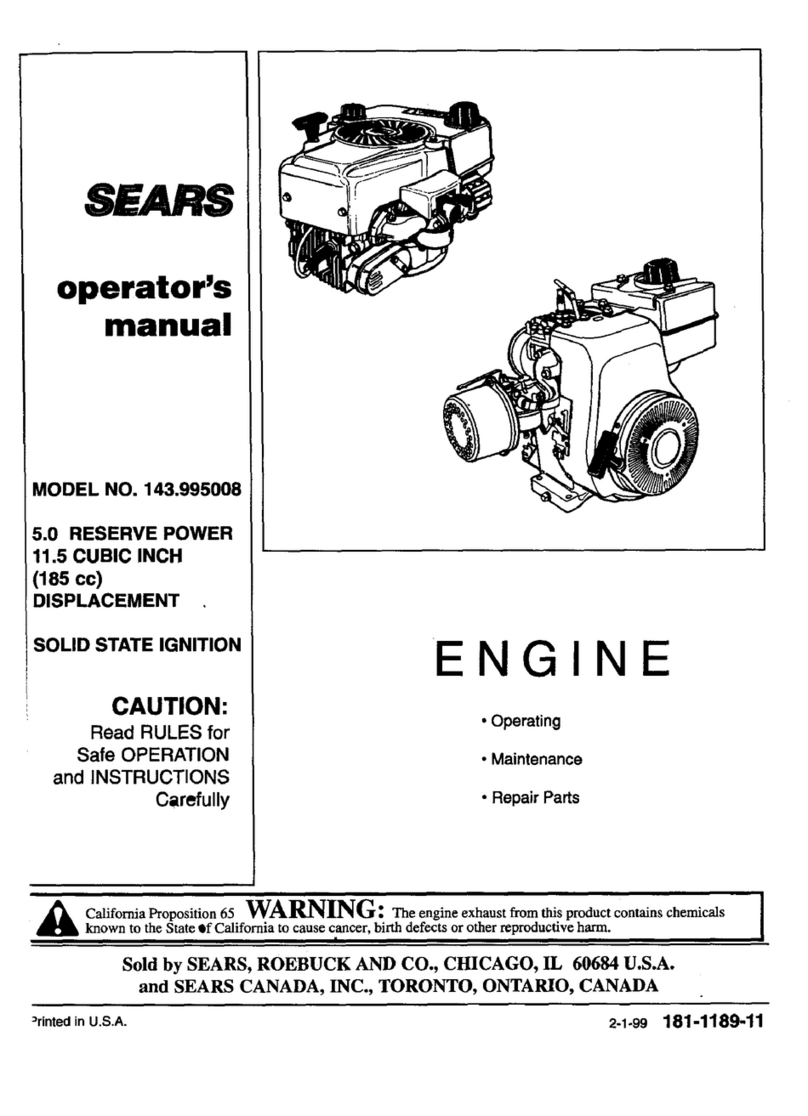
Sears
Sears 143.995008 Operator's manual
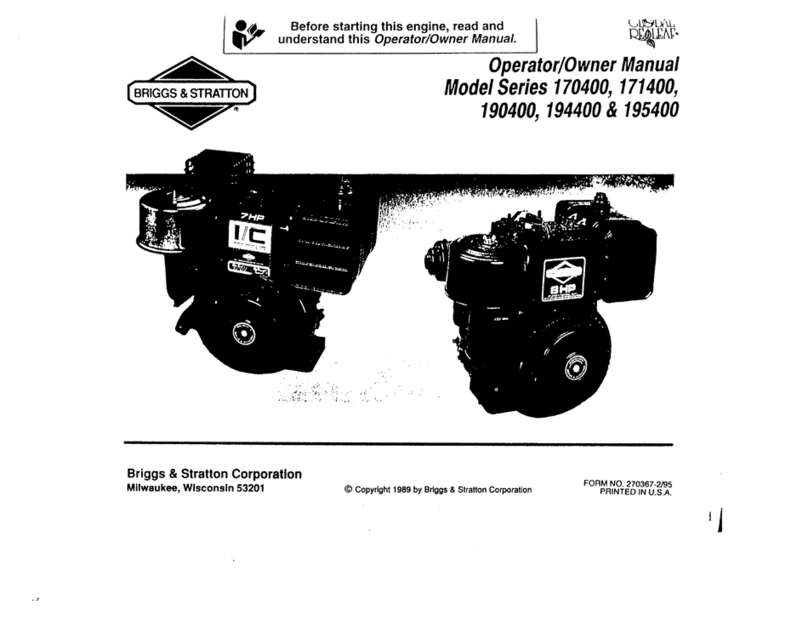
Briggs & Stratton
Briggs & Stratton Sno/Gard 170400 Series Operator owner's manual

Power Fist
Power Fist 8703126 user manual
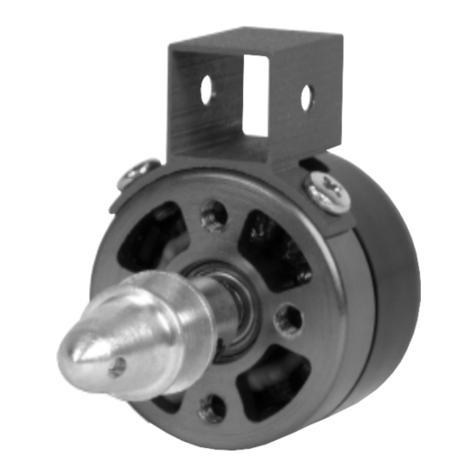
Himax
Himax HC2808 Series quick start guide

Nice
Nice Era Star A Series Instructions and warnings for installation and use
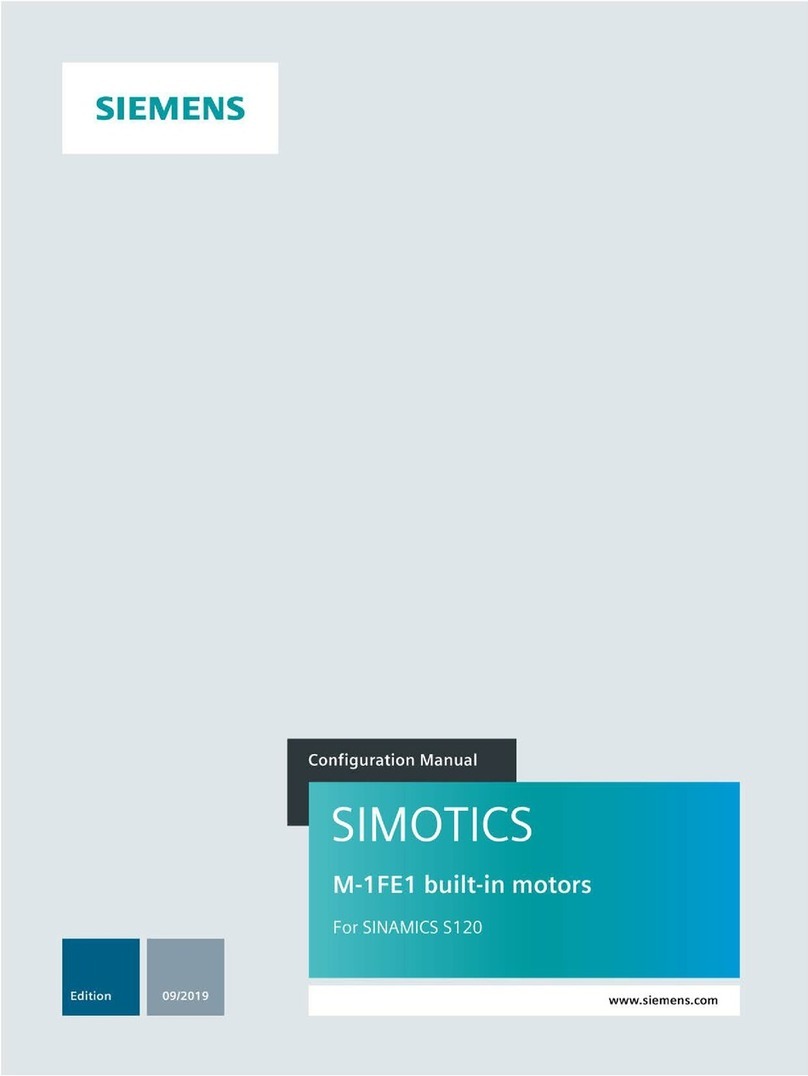
Siemens
Siemens Simotics M-1FE1 Series Configuration manual
